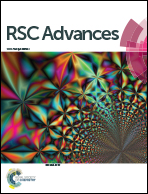Investigations on the development of MCM-41 as a potential mesoporous silica based reference material for the analysis of multi-textural properties†
Abstract
Investigations on the time dependent analysis of the structural and textural properties of the mesoporous silica material MCM-41 were performed by analyzing the samples at regular intervals for one year by powder X-ray diffraction (PXRD) and nitrogen sorption techniques for samples stored (i) under a dry nitrogen atmosphere in a glove box and (ii) under dry ambient atmospheric conditions. The stability and durability of this high surface area material gave promising results under both storage conditions in terms of its structural and textural properties. Under the typical storage conditions employed, the values of various textural properties, including the surface area (SA, m2 g−1), pore volume (PV, cm3 g−1), pore diameter (PD, Å) and wall thickness (WT, Å) determined by nitrogen adsorption were found to be 1030 ± 49, 1.015 ± 0.066, 27.55 ± 0.60 and 17.04 ± 0.61 respectively for the glove box samples. Almost identical values (SA = 1022 ± 45 m2 g−1), (PV = 0.933 ± 0.065 cm3 g−1), (PD = 27.54 ± 0.14 Å), (WT = 16.58 ± 0.81 Å) were obtained for the samples under ambient atmospheric conditions. The experimental analysis indicated that this material has potential as a standard reference material for the analysis of the multi-textural characteristics of high surface area mesoporous materials.


 Please wait while we load your content...
Please wait while we load your content...